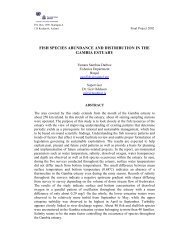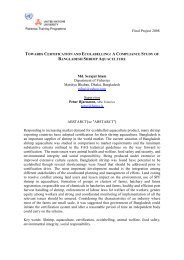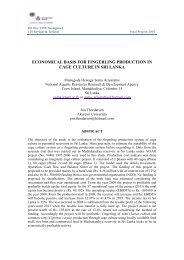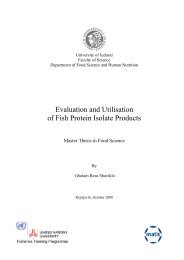Quality Indicators of Northern Shrimp (Pandalus borealis)
Quality Indicators of Northern Shrimp (Pandalus borealis)
Quality Indicators of Northern Shrimp (Pandalus borealis)
You also want an ePaper? Increase the reach of your titles
YUMPU automatically turns print PDFs into web optimized ePapers that Google loves.
Qingzhu2.3 Assessment methods <strong>of</strong> freshness and quality2.3.1 Sensory evaluationSensory evaluation is an important method for the assessment <strong>of</strong> freshness and quality,and is commonly used in the fish sector and fish inspection services (Martinsdottir 1997,Luten and Martinsdottir 1997). Sensory evaluation can be applied to all species <strong>of</strong> fishand laboratory facilities are not necessary. The evaluation is quick and non-destructiveunless the sample is being cooked, and moreover, the results <strong>of</strong>ten reflect the criteria theconsumer uses in evaluating acceptability (Connell 1990). Therefore, when chemical andphysical methods are being used for assessing the quality <strong>of</strong> fish, sensory evaluationshould be conducted to ensure that the results <strong>of</strong> the instrumental (objective) tests are inagreement with sensory analysis and thus indicating consumer perception (Alasalvar et al.2001). The quickest way, used by buyers and inspectors on the market, is to look at theappearance <strong>of</strong> the fish products, particularly the colour, luster <strong>of</strong> the shrimp. Thedisadvantages are that the evaluations <strong>of</strong> inspectors are difficult to standardize and theresults can be subject to the personal whims and biases <strong>of</strong> the assessors. However, mosttrade is based on sensory assessments, although measurements are not always objectiveand documented. The <strong>Quality</strong> Index Method (QIM), which as a method <strong>of</strong> sensoryevaluation, is a grading system based on adding demerit points for sensory attributes usedfor estimating the freshness and quality <strong>of</strong> seafood. The QIM has been demonstrated tobe rapid and more objective than sensory classification schemes <strong>of</strong>ten used by theindustry. QIM schemes have recently been developed for a number <strong>of</strong> fish speciesincluding: fresh herring, cod, red fish, Atlantic mackerel, mackerel, European sardine,brill, dab, haddock, pollock, sole, turbot, shrimp and farmed Atlantic salmon(Sveinsdottir et al. 2003).2.3.2 Chemical analysisSeveral chemical tests for freshness such as determination <strong>of</strong> amines, particularlytrimethylamine (TMA), and determination <strong>of</strong> hypoxanthine have been used for the pastdecades (Aitken et al. 1982). The former is related to bacterial activity while the latter isa measure <strong>of</strong> enzymic change. These two methods complement each other and havedifferent ranges <strong>of</strong> applicability and usefulness. A chemical test does not measurefreshness directly but the two are associated because the concentration <strong>of</strong> chemicalsmeasured is dependent on storage time and temperature, as freshness is.Trimethylamine, TMA, is formed in spoiling fish by the action <strong>of</strong> certain species <strong>of</strong>bacteria on the substance trimethylamine oxide, TMAO. Therefore determination <strong>of</strong>TMA content is a measure <strong>of</strong> bacterial activity and spoilage (Aitken et al. 1982). Increasein TMA during iced storage is similar to the increase in bacterial numbers. TMAO is notonly an important compound for maintenance <strong>of</strong> physiological functions in fish andshellfish but it is also a key substance in the spoilage <strong>of</strong> raw or processed seafood(Norman and Benjamin 2000). The TMAO content in the muscle <strong>of</strong> crustaceans is 9-28(mmole/kg wet weight) (Konosu and Yamagushi 1982).UNU-Fisheries Training Programme 8
















